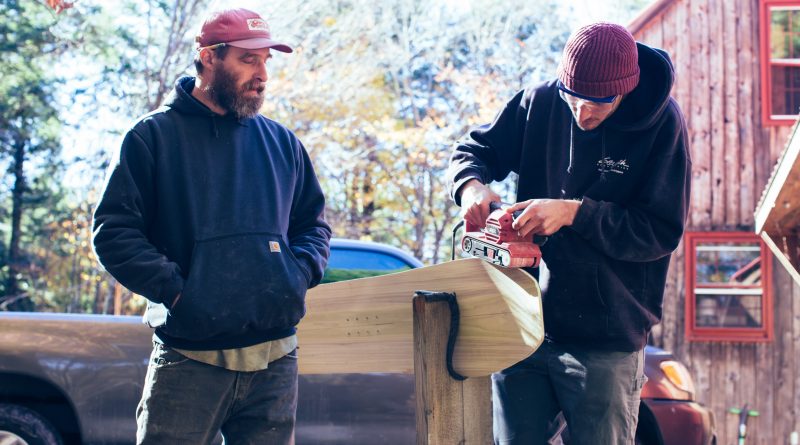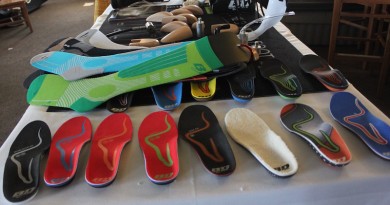DIY: Make Custom Boards Yourself
But it you want to make your own truly custom skis or boards, these guys can also help you. The DIY craze has taken off—and Vermont’s at the heart of it. Whether it’s learning to make a snowboard with a shaper in Peru, Vt., handcrafting wood skis with an artisan who works out of a trailer, or taking a class at Boston’s burgeoning custom ski builder, Parlor, here’s what you need to know to build your own ride.
PowderJet
Show up on a Saturday morning at PowderJet’s workshop in Peru, Vt. and by Sunday, you can have your own custom snowboard. “They have factories, we have a woodshop,” is the motto that Jesse Loomis gave his business, which he opened in 2009.
A carpenter by trade, Loomis, 42, found his calling in 2008 when he took a spin on the first Burton board he’d ever owned and found the old board could still perform in the deep snow. He was looking for a board that could maneuver through the tight woods of Vermont and float through deep snow like a surfboard: that early design had it.
“I realized I could tie all those qualities into one board and it actually worked,” he says. He added sidecut and flex. “My mindset was to create the cleanest, simplest snowboard with as small an environmental footprint as I could manage,” he says.
The next step was to teach others to make them.
After moving to Maine for two years and partnering with a surfboard maker, Grain, Loomis moved PowderJet back to southern Vermont in July 2016, and set up a shop and press in Peru with the idea of hosting classes there.
Then, after getting pleas from former pro rider Dale Rehburg to give a class in California, Loomis took PowderJet on the road. This past fall, the “Speed of Sawdust” tour took Loomis around the country. He’s hosted classes in places that range from the local West Dover, Vt. shop, Invasion, to Patagonia stores in Encinitas, Calif., New York and Boston. Loomis is also partnering with Parlor and hosting a workshop at their Boston headquarters on Feb. 25-26 and is then headed to Grain, in York, Maine, for another workshop on April 8-9. Loomis will also put on a custom class for four or more.
Loomis presses and shapes the boards himself, controlling the sidecut and flex. As he says, “I want to make sure they all have a similar ride.” But then the nose and tail shape and graphics are up to the individual. “For instance, some people want a deeper notch in the swallow tail, which impacts how deep it sinks in powder.” Students often sign up six months ahead of time. “They really like to nerd out on just what they want their board shapes and graphics to be. I even had one guy do this really cool dolphin tail on the board.” Graphics might entail painting or burning or etching the board. The final step is a Minwax finish that Loomis likes because it can be reapplied after the board gets scratched.
Though he now uses steel edges and P-Tex, Loomis has tried to stay true to his environmental ethos. Boards are shaped with FSC certified poplar wood sourced from the United States, and use an environmentally-friendly entropy resin. A class and a board cost $795. powderjet.com
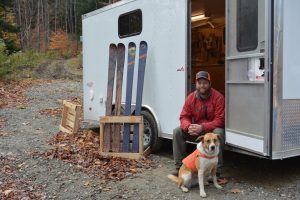
Silo
At the end of a long and narrow dirt road, a bumpy ten-minute drive from Cochran’s ski area and the rugged expanse of wilderness that surrounds Camel’s Hump, sits the global headquarters of Silo Skis: an 8-foot by 16-foot trailer, powered by a rumbling generator.
When it comes to boutique ski manufacturers, Silo Skis is about as small as it gets. That’s because Lars Whitman, sole employee and owner, doesn’t really want to make you a pair of skis. He wants you to make them.
Whitman, 42, grew up skiing in southern Vermont, linking turns at Mount Snow, Stratton and areas where the lifts no longer turn, including Hogback in Marlboro and Maple Valley in Dummerston.
After a stint living and skiing in Jackson Hole, he came back to Vermont in 2001 and started work in carpentry. Then, in 2013, he completed a six-week apprenticeship with Matt Neuman, a custom ski builder in Idaho.
Today, Whitman still does some carpentry and works for Citizen Cider in Burlington, but his passion is building custom skis and guitars.
The idea for a portable factory came after seeing the setup of 333 Skis, a two-person team in Mammoth Lakes, Calif. that had its entire operation based in a similar trailer.
“I found that I really don’t need much space to work in,” he says. “The trailer forced me to have my entire workspace planned out.”
The nondescript trailer includes interlocking cabinets and shelves that hold supplies, peg-boards and drawers for tools and a specialized jig Whitman has designed for shaping the ski and adding camber or rocker. Another space under a counter is where the skis are pressed. A gas-powered generator behind a panel provides power when he’s on the road.
Whitman likes this mobile setup as it allows him to take his operation directly to the mountains. It takes him about 16 hours to produce a pair of skis and last year he had 30 orders. Half of those were from folks who wanted to roll up their sleeves to build their own pair.
Whitman has yet to take the trailer to a customer’s house (something he’s looking forward to trying). Instead, customers make the drive up the dirt road in Richmond to work in the trailer over a weekend. Whitman says it takes about 16 hours to complete a pair of skis.
He starts his design with a questionnaire that addresses everything from what kind of snow the skis will be used on, the skier’s style (examples: “leisurely, ski like a freak, charge everything, bump-a-holic, and Chuck Norris”), the kind of bindings that will be used and any graphics.
Whitman uses birch cores, fiberglass, epoxy, metal edges, and conventional base materials.
He eschews the idea of a “quiver of one” ski. Instead, he tries to steer customers to where they ski most 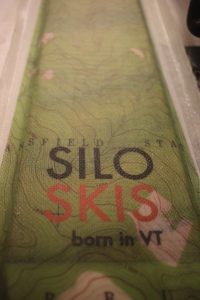 of the time.
of the time.
“If you ski on the East Coast, there’s a pretty good chance you’ll be skiing the same stuff over and over,” he says. “What we do is design the ski that hits the sweet spot, that area where you ski 90 percent of the time. In designing the ski, it’s about education as well.”
Instead of simply building the skis to spec and then sending them on their way, much of the process is spent discussing the methodology.
“I want people to understand what we’re doing and how that affects what we do down the line,” he says. “When you see someone pulling their skis out of the press and cutting them open, the excitement is palpable. It’s the most fun,” he says.
A pair of Silo Skis costs $700 and with a one-on-one workshop, is $850. This winter, look for the Silo Skis trailer in the parking lots at Mad River Glen, Sugarbush and Killington, where you can demo pairs of skis and sign up to build your own pair. siloskis.com
Parlor
When it comes to DIY skis, Parlor is to Silo what Boston, Ma, is to Richmond, Vt. Though based right near Logan Airport, Parlor’s founders, Mark Wallace, Jason Epstein and Pete Endres spend many winters skiing Vermont. “It’s our test bed,” says Wallace.
The three met when they were ski racing at Williams College. Wallace raced semi-pro for a while after and then went to work for a construction company where he learned about materials and how to build.
After getting his MBA, Wallace teamed up with the other two to launch Parlor. It started in 2009 in a Cambridge building that once housed a funeral parlor.
The original idea? “We wanted to make custom skis that were really geared to the terrain that people ski around here,” says Wallace. “We realized there really wasn’t a New England ski brand and we wanted to make one that would make people’s ski days better here.”
One of the first questions Parlor asks any customer is: “What runs do you ski?” “It makes a difference because there’s a good chance we’ve skied that run and we’ll know what the terrain is like,” Wallace says.
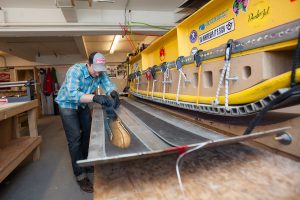 While Parlor has some set models (ranging from the all-mountain Cardinal to the 120-mm powder gnasher, the Heron) each ski gets adjusted for a customer’s weight, height, skiing preference and, of course, custom graphics.
While Parlor has some set models (ranging from the all-mountain Cardinal to the 120-mm powder gnasher, the Heron) each ski gets adjusted for a customer’s weight, height, skiing preference and, of course, custom graphics.
After moving to a warehouse space out by Logan Airport in 2015, Parlor began offering a few workshops where people could come in and build their own skis. “It started out as few friends of ours wanting to come over and see what we did. Now, we have classes that run from April through August,” Wallace says. Some businesses even book ski building classes as corporate outings.
The space now comprises 3,500 sq. ft. and classes can include six to eight people. “It takes about 8 to 10 hours to make a pair of skis,” says Wallace.
During that time, he guides students through the process of selecting the wood cores, shaping, hand-gluing the edges, applying the resins, laminating and, as Wallace calls it, “the fun part — the graphics.”
You can either work with Parlor’s designer to come up with a graphic or create one on your own.
In 2016, the classes sold out and for 2017, Parlor’s extended the schedule to include both intensive weekend classes and weekday after-work classes that run from 5 p.m. to 9 p.m. Classes cost $1500 and include the pair of custom skis you build. For $25, you can also just sign up for a “Shop Night,” which gets you a t-shirt, a beer and a chance to hang out and watch the process. parlorskis.com
Yes, but how do they do on snow?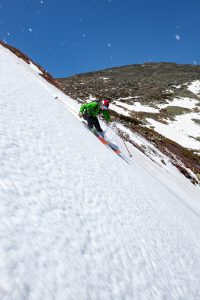
Sure, these microbrands are cool, but how do they perform? Excellent question, Bueller. We’ve tried many of the boards that are made in Vermont and, frankly, are impressed. But don’t take our word for it. Recently, we worked with Exotic Skis, an unbiased, unaffiliated group of ultra-techy ski testers who specialize in in-depth reviews of small-batch skis. They put our local boards through their paces and, as of press time, have created detailed reviews of Parlor, J, Renoun and WhiteRoom skis. To see what they have to say, visit vtskiandride.com.
*featured photo by Shem Rose

